
Gary Blankenship and Chuck Leinweber depart Tampa in Gary's Frolic2, destination Key Largo.
Contents:
Contact info:
Jim Michalak
118 E Randall,
Lebanon, IL 62254Send $1 for info on 20 boats.
Jim Michalak's Boat Designs
118 E Randall, Lebanon, IL 62254
A page of boat designs and essays.
(15mar06) This issue will do more sail rig figuring for the new Raider design. The 1 April issue will take us along the Extreme Challange 2006 with Gary and Chuck.
THE BOOK IS OUT!
BOATBUILDING FOR BEGINNERS (AND BEYOND)
is out now, written by me and edited by Garth Battista of Breakaway Books. You might find it at your bookstore. If not check it out at the....ON LINE CATALOG OF MY PLANS...
...which can now be found at Duckworks Magazine. You order with a shopping cart set up and pay with credit cards or by Paypal. Then Duckworks sends me an email about the order and then I send the plans right from me to you.
MESSABOUT NOTICE:
THE REND LAKE MESSABOUT WILL TAKE PLACE ON JUNE 9, 10 AND 11 AT THE GUN CREEK RECREATION AREA AT REND LAKE IN SOUTHERN ILLINOIS. MORE DETAILS WILL FOLLOW BUT IT MIGHT BE PRUDENT TO MAKE CAMPING RESERVATIONS IF YOU INTEND TO ATTEND.

|
Left:
Gary Blankenship and Chuck Leinweber depart Tampa in Gary's Frolic2, destination Key Largo.
|
|
|
Raider Design 3
BACK TO THE RAIDER, AGAIN....
To review, last time we looked at Raider we got into more details with the sailing rig.

I did not size the rig in my usual way since the Normsboat sailrig was already at the builder's hand and a "given". But after thinking about it I decided to take a second look at it, just to be sure it would not be overwhelming and also to get a idea of the power a hiking crew can produce on a boat like this.
First, I got out my Hullforms model:
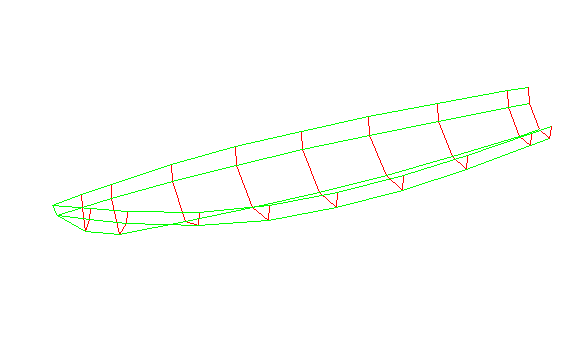
I took a look at it's waterline at 1100 pounds total which I take to be the total of a 400 boat with 700 pounds pf crew. It floated right as desired, with the chine just touching the waterline:

Then I varied the heel angle in the program until I knew how far it would heel before water came over the side. Turns out that happens at 35 degrees, like this:

There would be no point in worrying about righing moment beyond that point.
Just for the fun of it I ran the option where Hullforms draws a righting moment curve with the hull empty, at 182 kg which is 400 pounds. I got this:

By dumb luck the maximum righting moment occurs at a roll angle of 35 degrees, the same as our swamping angle. So we aren't losing any performance by being too low sided. Let's see, it says the max Gz, the righting arm, is .12 meters, which is 5". So the naked hull would capsize when a rolling moment of 5 x 400 = 2000 in lb is applied. That really isn't much. For example, this hull is 60" wide so force of just 67 pounds applied to the wale at the hull's widest point will cause it to capsize. One must be careful when boarding to step into the middle of the boat. With a deep V boat this is not a surprise.
Next I ran the same option at the normal operating weight of 1100 pounds (500 kg). I got this righting moment curve:
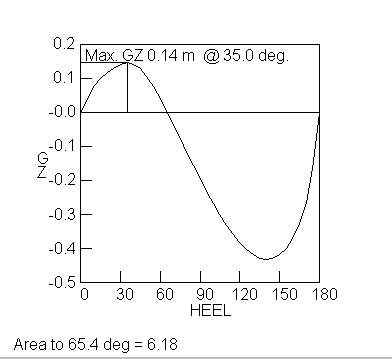
Still not a lot. The maximum righting arm is .14 meters (5.5") and with a total weight of 1100 pounds, the maximum righting moment will be 5.5x1100=6000 inch pounds. Most of the added stability is just from the extra weight. The waterline has changed and gotten wider so the stability due to the shape of the hull has also increased a bit. But this might be the curve to use while if the crew keeps their weight centered in the hull, as they would while rowing while sailing.
Ok, now the question is how hard will the wind blow to make this rig capsize the boat with the crew centered? This will assume the boat is close hauled and most of the sail force is sideways, only a small percentage of the sail's force is pushing the boat forward, most of the sail's force is pushing the boat sideways and that force is opposed by the leeboard way down low. On this rig the center of the sail and the center of the leeboard are about 14' apart, or 168". So a sideways force on the sail of just 6000/168=36 pounds will cause her to swamp. How does that relate to wind speed?
There are a lot of assumptions required here, getting from wind speed to sail force. I suppose the main assumptions are that all of the sail area is effective (that may not be true due to sail twist, etc.) and the "efficiency" of your sail. But the force on a sail, as with an aircraft wing, is usually shown to be:
F=.0034 x S x C x V x V where:
F is the force in pounds. S is sail area in square feet, V is wind speed in knots, and C is a "force coefficient". We know the sail area of a Normsboat sail is 115 sq ft. We are trying to solve for V. C is going to be about 1.5 for a "good" sail but can vary from maybe 1 for a crude sail to maybe 2 for a super sail.
So we have 36 = .0034 x 115 x 1.5 x V x V which equals .58 x V x V. Or rearranging we get V x V = 61. A quick look at the calculator shows V = 7.8 knots in this condition will capsize the boat. I would think the crew could try to row/sail in those conditions. It would be a noticeable breeze and then some. Most likely some of the crew will have to drop their oars and hike to one side to keep the boat level so those rowering could still row.
CREW WEIGHT TO WINDWARD...
If it breezes up some more, what to do? You could reef down and keep rowing but most likely you wouldn't want to do that. Instead the crew could drop their oars and all "hike" out to windward. Like this:

As you see, If the whole crew of 700 pounds gets into the hike then there is a potential righting moment of about 17000 inch pounds available. There might actually be more since I am showing the situation where the hull is not heeling. If the hull heels some then it will pick up some form stability but it will start to lose the effect of the hiking crew (you can imagine that if the boat heeled to say 90 degrees then the effect of the hiking crew would be nothing or negative).
So now what sort of wind speed are we talking about? 17000 inch pounds divided by the spread of sail/leeboard of 168" gives us a sail force of about 100 pounds at capsize. So we have 100 = .0034 x 115 x V x V = .58 x V x V and V x V = 100/.58 = 172. Another glance at the calculator gives V =13 knots.
That is a good breeze with whitecaps, crew hanging over the side to keep her down and the rail down! No need for oarsmen now. Looking at it that way I'd say the size of the sail is OK.
And this is by no means extreme hiking. That might take the form of sitting on the rail or hanging over the side of the boat on a trapeze that is lined to the masthead, Or maybe a "hiking board" as used in extreme racing canoes that puts the crew many feet over the side of the hull. Of course, if the wind lulls while you are doing this you will capsize backwards!
There is another important bit of info to glean from this. Let's say the mast at its root is 3" square, this at a point about 120" from the sail center, so the bending moment on the mast at that point, with the crew sitting to the side, is 100 x 120 = 12000 inch pounds. The elastic bending stress in a square cross section is equal to 6M divided by the thickness cubed, that is the mast thickness is multiplied by itself twice. So the bending stress in this proposed mast would be 6 x12000/(3x3x3)=72000/27=2700 psi. This is below the allowable for almost any sort of wood and in the best selected woods like Sitka spruce we might push bending stress to maybe 5000 psi or more. But I would not push my luck here since there are so many variables and breaking a mast will only happen at the worst possible time and will be a disaster.
NEXT TIME...
...I hope we can join Gary Blankenship and Chuck Leinweber in a review of sailing Gary's Frolic2 from Tampa to Key Largo in the Extreme Challange 2006 race!
PICCUP PRAM

PICCUP PRAM, SAIL/ROW PRAM, 11' X 4.5', 90 POUNDS EMPTY
Piccup Pram was the first boat of my design to get built, back in 1990, I think. I still have the prototype and use it regularly. I designed it to be the best sail/row boat I could put in the back of my short bed pick up truck. But I found it to be a good cartopper, too. It has capacity and abilities I had previously thought impossible in a 90 pound cartopper. The photo above shows the original 55 square foot sail on Pensacola bay a long time ago. Piccup is a taped seam multichine hull which can take a fair amount of rough water.
Piccup continues to be one of my most popular designs and I get nice photos from builders. Here is one of Richard Donovan hoping for more wind up in Massachusetts.
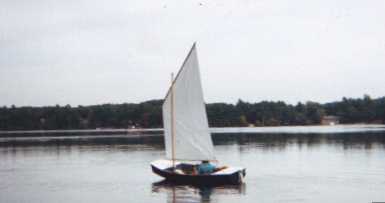
Richard's Piccup has the larger 70 square foot sail that prefer myself. It's the same as the original but is 2' taller. This balanced lug sail sets on a 12' mast and rolls up easily for storage on its 9' yard and boom. The idea was to be able to store the rig easily in the boat during rowing and it works. There is a pivoting leeboard and kickup rudder on the boat and they can be left in place raised while rowing. Converting to full sail takes a couple of minutes as you step the short mast, clip on the halyard and tack lines, hoist the sail, lower the boards, and off you go. And the balanced lug sail reefs very well although reefing any small boat is best done on shore.
Here is a Piccup by Vince Mansolillo in Rhode Island, a nice father/son project. Piccup will be large enough to hold both of them. You can see the large open frameless cockpit, large enough for sleeping. And you see the buoyancy/storage boxes on the end.

But Piccup will take two adults as seen in the photo of Jim Hudson's boat. Jim's boat has a polytarp sail as does my own Piccup.

These boats have proven to be good for sail rig tinkerers (be sure to read and apply the Sail Area Math essay before starting). Here I am in Piccup with a polytarp sharpie sprit sail. The rig is different from the originals but the hull here is totally unchanged (except for paint) from the original shown on the beach at Pensacola.

I think my own Piccup has had about six rigs of different sorts and was always the test bed for the polytarp sail experiments. But, hey!, that's nothing compared to the tinkering Reed Smith did with his out in California. Here is his Piccup rigged as a sharpie sprit yawl!

Here is Rob Rhode-Szudy's yawl rig Piccup that was featured in his essays about building Piccup that you can access through the old issue links.
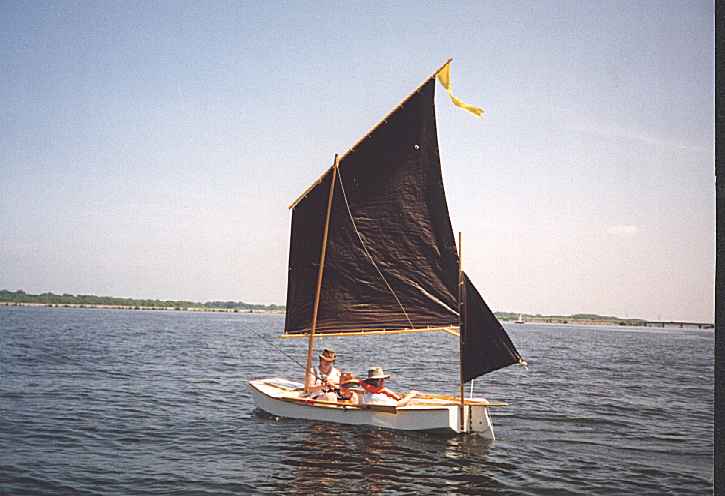
Here is another by Doug Bell:

This one is by Jim Islip:

And this one by Ty Homer:

Piccup Pram uses taped seam construction from five sheets of 1/4" plywood.
Plans for Piccup are still $20.
Prototype News
Some of you may know that in addition to the one buck catalog which now contains 20 "done" boats, I offer another catalog of 20 unbuilt prototypes. The buck catalog has on its last page a list and brief description of the boats currently in the Catalog of Prototypes. That catalog also contains some articles that I wrote for Messing About In Boats and Boatbuilder magazines. The Catalog of Prototypes costs $3. The both together amount to 50 pages for $4, an offer you may have seen in Woodenboat ads. Payment must be in US funds. The banks here won't accept anything else. (I've got a little stash of foreign currency that I can admire but not spend.) I'm way too small for credit cards.
The out West Picara is I am told done to the point of using it as a powerboat:
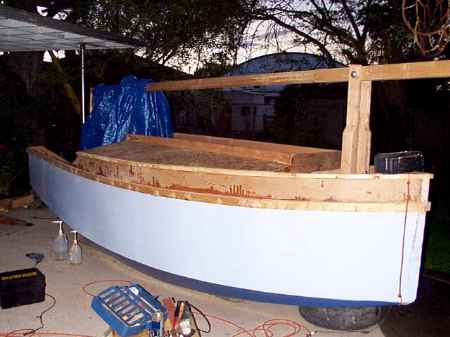
The down South Picara is more or less complete now. Should have an updated photo soon.

This long and lean project is a 19' version of Toon2. Shown here on its first sail in very light winds. We will wait a bit longer to get a sailing report in stronger winds.

A Vector builder is keeping a website of the project at http://www.geocities.com/michsand@sbcglobal.net/ and here is a photo of his boat on its first sail, just before the storm hit. I also have photos of a Vector completed by Pete Mohylsky in Florida. Hopefully a report soon:

Here is a Musicbox2 I heard about through the grapevine.

We have a Philsboat going together in California:

And here is another Philsboat in northern Illinois:

AN INDEX OF PAST ISSUES
Hullforms Download (archived copy)
Plyboats Demo Download (archived copy)
Brokeboats (archived copy)
Brian builds Roar2 (archived copy)
Herb builds AF3 (archived copy)
Herb builds RB42 (archived copy)